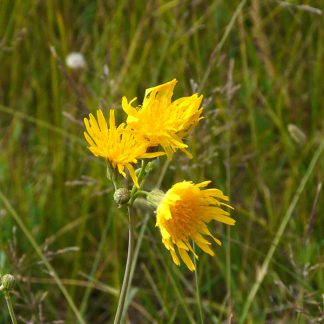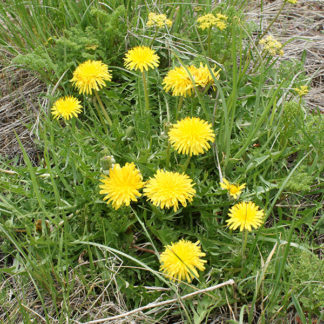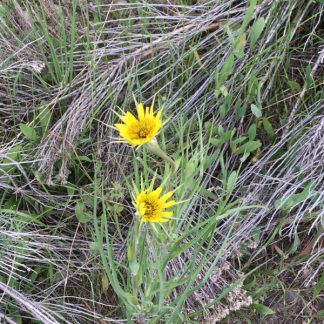Asteraceae
Showing 49–60 of 63 results
-

Rudbeckia occidentals / western coneflower
- dark cone-shaped flower head - like a sunflower without petals
- ring of yellow "bumps" visible during pollination time
- "cones" about 1" but double that when in seed.
- usually a tall plant with sunflower-like leaves
- alternate (not opposite) leaves
-

Senecio integerrimus / tall western groundsel
- early spring to early summer, often with larkspur
- bright yellow flower head with several, disheveled looking blossoms
- only 5-13 ray florets (petals)
- cobwebby hairy basal leaves, especially when young
- seasonally moist areas, from sagebrush to higher parts of the fen
-

Senecio triangularis / arrowleaf ragwort
- leafy stems with arrow-shaped, coarse-toothed leaves
- often in large patches on moist soil
- clusters of yellow flower heads, each with 8-ish untidy ray florets
- numerous green involucral bracts, sometimes with black tips
- largest leaves occur mid-stem
-

Solidago canadensis / goldenrod
- large sprays of yellow flowers in late summer and fall
- often tall and in large colonies
- lance-shaped, toothed leaves
- mostly (but not always) in disturbed areas
-

Solidago missouriensis / Missouri goldenrod
- perennial herb, up to 40" tall
- inflorescence is a branching panicle with many (≥200) yellow flower heads
- involucres are ¼ long with 3 or 4 layers of narrow, pointed, hairless, yellow-green bracts
- leaves are thin and lanceolate, upright and rigid with prominent midribs
- upper leaves have pronounced but small teeth
-

Solidago multiradiata / alpine goldenrod
- the only (?) goldenrod at alpine altitudes
- clusters of 5-100 small, yellow composite flowers with a dozen-ish rays and 3 doz disc florets
- medium green lance/spoon shaped leaves, bigger at base of the plants; toothed/hairy edges
-

Sonchus arvensis / field sowthistle
- yellow dandelion-like
- multiple flowers per stalk
- often in patches in wet fields
- leaves spiney but without lobes, clasping the stems
- often several stems from a single point at the soil level
-

Stenotus acaulis / stemless goldenweed
- very short, mat forming perennial yellow "daisy"
- thin, lance-shaped leaves, pointing upward
- yellow flower head with 6-15 ray florets, up to 50 disk florets
- in dry, rocky, open-scrub habitats
-

Taraxacum officinale / dandelion
- rosette growth habit with lobed leaves
- yellow dandelion-like flowers - composites with only ray florets
- only one flower head per stem
- characteristic puff-ball seedheads
- found anywhere and anytime
-

Tetradymia canescens / spineless horsebrush
- shrub - up to 3 feet tall and across; round
- small, yellow composite flowers in clusters of 4 to 8
- dandelion-like seeds often present with flowers
- primary leaves short and linear; long-lived
- secondary leaves in axils of primaries are short-lived
- primary leaves are not spines
-

Tragopogon spp. / salsify
- large yellow inflorescence with pointy sepals extending past the "flower"
- grass-like leaves
- non-native, weed
- widespread
Showing 49–60 of 63 results
